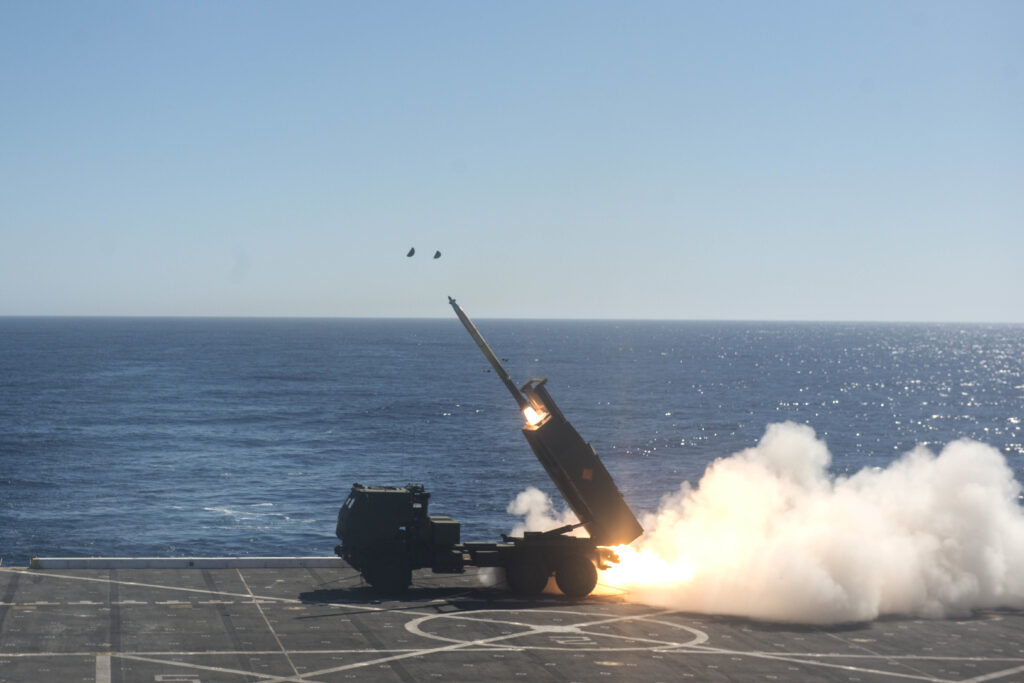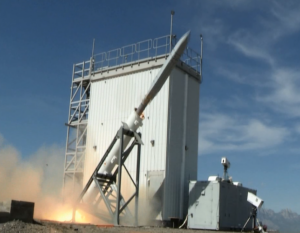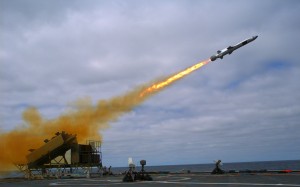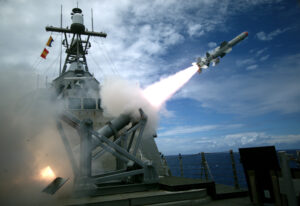Marines Want Missiles To Sink Ships From Shores, And They Want Them Fast
Posted on

A Marine HIMARS missile launcher fires from the deck of the USS Anchorage during the Dawn Blitz 2017 exercises.
WASHINGTON The Marine Corps has kicked off a rapid development program to begin firing long-range anti-ship missiles from shore-based ground vehicles in an effort to add more punch to the Navy’s growing anti-ship capabilities, which are aimed squarely at Chinese and Russian advances.
Dubbed the Navy-Marine Expeditionary Ship Interdiction System — that’s NEMSIS to you — the program has completed its design phase. For the missile itself, Marines are looking at
- Lockheed Martin’s new Long-Range Anti-Ship Missile (LRASM), with stealthy features to penetrate enemy missile defenses, a 1,000-pound warhead, and a range disclosed only as “over 200 miles”;
- Raytheon’s Naval Strike Missile (NSM) already chosen as an upgrade for Navy Littoral Combat Ships, with a 264-lb warhead and a 115-mile range;
- and Boeing’s venerable Harpoon, whose variants have a 500-lb warhead and ranges between 70 and 150 miles.
The program kicked off last year with a request for information (RFI), after which companies signed OTA agreements with the service in September. Final proposals were submitted in December.

The first firing of a Long-Range Anti-Ship Missile (LRASM) from the kind of vertical launcher used on Navy ships.
“The Marine Corps has been looking for a shore-based capability to meet PACOM demands,” Lockheed’s Scott Craig told me Wednesday on the sidelines of the Surface Navy conference here. “The Army is looking at this too but probably on a different timeline — the Marine Corps wants to get after this pretty quickly.”
(The last administration announced an anti-ship version of the Army’s ATACMS, which has a modest 188 mile range, but details on the upgrade have been sparse; the service’s ATACMS replacement, the Precision Strike Missile or PrSM entering flight test this year, may also have an anti-ship variant).
The Corps is looking at three different wheeled vehicles to launch the missiles: Lockheed Martin‘s M142 HIMARS, which is already configued to fire GMLRS and ATACMS rockets, and two large, heavy-duty trucks from contractor Oshkosh, the Medium Tactical Vehicle Replacement (MTVR) truck and the Logistic Vehicle System Replacement (LVSR).
Craig said the Marines are looking for a mobile unit “that can shoot and move very rapidly. They’ve done the engineering analysis. They’ll start building prototypes in March and test by the spring of 2020.”
He added that, from a Lockheed perspective at least, “there’s some software we install in the vehicle and we use the same mission planning system that we use for surface launch, as well. We really take all of that previous effort we’ve developed over the past several years and adapt it to a ground vehicle.”
In 2017, the Marines fired the HIMARS system from the deck of the USS Essex during the Dawn Blitz exercise, marking the first time the self-contained, vehicle-launched rocket system has been fired from an amphibious ship.
The Marines’ concept for future warfare calls for creating a series of small island outposts called Expeditionary Advanced Bases (EABs) able to shoot down enemy aircraft and sink enemy ships in the surrounding seas, acting as an unsinkable anvil to the fast-moving hammer of the US Navy and Air Force. China already uses long-range land-based missiles to try to keep US air- and seapower at bay, a strategy known in the West as anti-access/area denial (A2/AD). With cooperation from Japan, Taiwan, and the Philippines, the US could create its own A2/AD missile outposts along the so-called First Island Chain to keep Chinese forces from moving east to attack their neighbors.
The Marine push comes as the Navy is also doubling down on its ability to hit enemy ships at distance. Late last year, the Navy moved out on a program to arm its Los Angeles-class attack submarines with ship-killer missiles for the first time in decades, using an updated model of the decades-old Harpoon.
Sydney Freedberg contributed to this story.
Subscribe to our newsletter
Promotions, new products and sales. Directly to your inbox.


